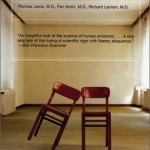 From Don’t Try This Alone: “‘When mammals showed up on the planet, their method of reproduction was different. Unlike reptiles, they gave birth to live helpless young that had to be nurtured or wouldn’t survive,’ said [A General Theory of Love] co-author Dr. Tom Lewis in a 2008 interview. ‘The parent had to monitor the physiology of the baby.
From Don’t Try This Alone: “‘When mammals showed up on the planet, their method of reproduction was different. Unlike reptiles, they gave birth to live helpless young that had to be nurtured or wouldn’t survive,’ said [A General Theory of Love] co-author Dr. Tom Lewis in a 2008 interview. ‘The parent had to monitor the physiology of the baby.
‘This led to the development of a part of the brain called the Limbic Lobe, which we share with all mammals. Infants’ physiology is incomplete on its own; babies can’t get to sleep on their own, they need to be lulled to sleep; they can’t soothe themselves, instead they seek out someone who can soothe them.
‘Just as infants need the regulating presence of the external contact figure, all of us are like infants, only bigger, and we also need the regulatory influence… Most people think their body is self contained, that sugar levels are monitored internally and so on, oxygen, hormones. It’s very surprising that this is not true – there are physiological parameters regulated by other people outside our own body.
‘In our culture we construe loneliness as weakness, as a character defect… But it’s based on brain evolution; there’s no choice about it. Just as when you’re hungry, or low on water and feel thirst, loneliness is a real physiological feeling telling you you need something vital. It hurts so much because it’s important to your health.’
Love is the glue that keeps people and societies together, says Dr. Richard Lannon in a terrific series of mp3 clips of interviews by radio host Paula Gordon. He explains fundamental human biology which makes our connections to others fundamental.
He relates the mammalian brain’s limbic system to being alive, to parenting, to being happy, to appreciating beauty and explains why we cannot ‘think our way’ to fulfillment.”
***
Back to Around the Web











